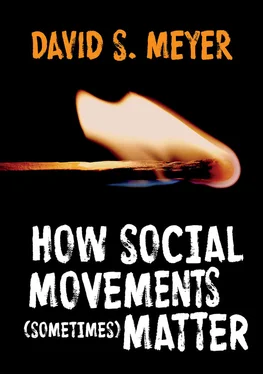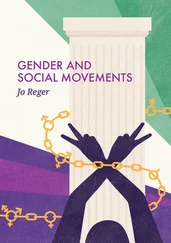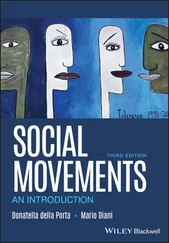Challenging and Entering Political Institutions
Social movements are not unitary actors. Because a movement contains a diversity of organizations and individuals, often including people with at least one foot in governance or mainstream politics, the politics of coordination and cooperation within a movement is critical to its development and its ultimate impact. Allied organizations argue about which issues are most pressing or promising, and how to address them most effectively. They argue about which political leaders to trust, and which ones to target. They argue about who will represent their efforts and who will be kept off the podium. And they argue about how to get things done. All of this matters.
Perhaps more significantly, movement activists are not the only ones who decide what they want, who their leaders are, and what constitutes acceptable progress. All of these issues are contested in public, with authorities, media, and supporters playing a role in advantaging some ideas and people at the expense of others. To take an example, while the organizers of a rally can decide who will appear on their speakers’ roster and when, outside coverage of those speeches need not follow the organizers’ preferences. Similarly, when social movements advance broad calls for social change, media outlets choose which to cover most extensively and which to ignore.
In democratic states, media generally follow public attention, and are likely to give the most attention to the most dramatic events, that is, actions that involve conflict and/or celebrities and/or theatricality (Rohlinger 2015, 2019). Organizers compete with the range of other events in life, as well as other contingents of activists, to capture the attention of mainstream media. Mainstream media are also likely to follow public interest in identifying spokespeople, which means gravitating toward celebrity, novelty, and clarity. Organizers who are media savvy know how to promote themselves and their cause, how to return inquiries quickly, and how to provide media outlets with the sort of quotes or appearances that will draw audiences. Thus, a movement that, like most, contains multiple factions, may see itself portrayed as offering a more radical or more modest set of claims than most at the grassroots support. Actually, media outlets face a clear choice: they can promote and cover radical or outlandish aspects of a social movement – and every movement has some – thus contributing to discrediting or marginalizing that movement. Alternatively, they can promote the most mainstream and least contentious elements of a movement, reducing the claims of those in the streets to those which are not too threatening. The nuclear freeze campaign, for example, a movement for nuclear disarmament and a reconfiguration of foreign policy, started in the 1970s and gained little political traction. In the early 1980s, however, it won widespread public support as politicians redefined it as a return to a superpower arms control process that accepted large standing nuclear arsenals as a reality of modern life (Meyer 1990).
Government officials also make choices about which people and proposals to legitimate by discussion and which to marginalize through neglect or ridicule. Like media, they face similar choices in emphasizing the outlandishness of a particular movement, or its utter reasonability and pragmatism. Those officials can also choose to recognize some individuals as spokespersons for a movement, ignoring others. There is an inherent difficulty in finding spokespeople who have sufficient credibility with the grassroots to still political protest, yet are willing to negotiate moderate policy reforms with authorities. For example, the minority white government in Rhodesia, facing domestic pressure, a guerrilla war, and international sanctions, sought to respond by designating Black leaders of moderate groups that it could negotiate with. The eventual negotiated agreement, however, did nothing to still either the guerrilla war launched by other Black leaders or even international pressure. The attractive negotiating partners couldn’t deliver the peace the white government wanted. Eventually, the government had to deal with the opponents who commanded armies (Matthews 1990).
In much of the world, activists launch effective movements without guerrilla armies, but the same sorts of dilemmas remain for authorities. Seeking to maintain a governing majority and reduce disruptive protest, they want to find opposition leaders who aren’t too oppositional, yet retain sufficient credibility with activists to be able to reduce disruptive protest. At the same time, movements at the grassroots struggle to hold their own leadership accountable to the ideas that motivated them in the first place.
Taken together, the elements of a movement suggest a stylized process through which a movement cycles. The prospect for potential impact is everywhere in that cycle, but it’s critical to recognize that movements don’t work in a vacuum, and that their influence is determined by their relations with other actors, inside and outside of government.
We might begin by acknowledging that there are always people who are trying to convince others that something in their society is drastically wrong, and to recruit those people into purposeful action to change it. The range of issues is virtually infinite: individuals can be upset about moral failures in the larger society; economic injustice; the prevalence of male circumcision; the persistence of female circumcision; the lack of civil liberties; the availability of guns; the use of public lands; the degree of civil liberties afforded most citizens; foreign policies; wars and preparations for wars; taxation; or the distribution of food. Discontent with a set of issues is normal. In any polity, some of those who are dissatisfied will be working through normal political channels – whatever they are – to secure their interests; others will be located well outside normal political actions, confined to the margins of mainstream discourse. Visibility is low, and there is little contact with a public that isn’t normally concerned with those issues. It’s not that everyone involved is happy or satisfied with the status quo, but rather that most people concerned with a set of issues view the established politics of the issue to be relatively stable, with changes on matters of policy taking place in increments. Political stability tends to reflect stalemate rather than satisfaction (Baumgartner and Jones 1993).
Social movements commence when institutional actors look to develop an outside strategy to pursue their aims – or those on the margins suddenly see greater success in reaching a broader audience – or both. This is usually a function of what’s going on in mainstream politics. They have to be convinced that additional means of politics are necessary and potentially effective. Those who are normally on the margins suddenly seem more relevant and potentially influential. Most interesting, those on the margins now can see common cause with those normally confined to mainstream politics.
When does this happen? Usually these moments are a reaction to regular politics and policy. When new leaders come to power and develop different coalitions of support, pushing some previously used to ostensibly meaningful political access out of political institutions, and welcoming those normally excluded in, the calculus of would-be activists changes. When political leaders offer new policies that depart from previous practices, partisans can sense a possibility of influence or the threat of severe losses. Most people take to the streets when they think their efforts are both necessary and potentially effective.
We can see reciprocal processes of mobilization coming from the mainstream and the margins. The public events of dissidents get larger, and generate more interest. Those who operate within more mainstream politics generally now take more time and effort to expand their audiences and explain their concerns to public groups they can normally ignore. As Schattschneider (1960) noted long ago, the important actors in a fight are usually the bystanders, who have the potential of taking sides. Successful social mobilization means engaging the crowd. Under normal circumstances, those at the margin have great difficulty doing so, and risk having the largest part of the public join on the side of the opposition. Under normal circumstances, those comfortable in mainstream institutional politics have no interest in doing so.
Читать дальше












